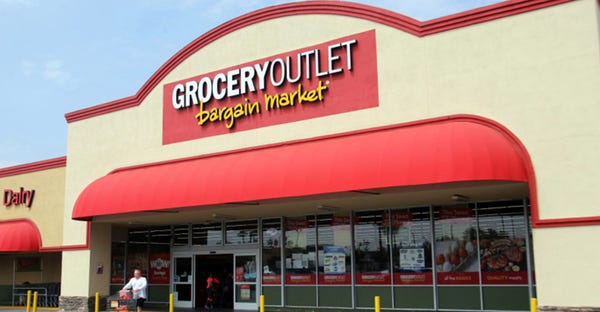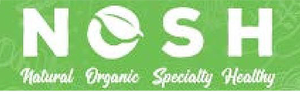June 25, 2019

If you’ve ever visited a Grocery Outlet, the first thing to jump out at you was probably the deep discounts.
With 310 locations (and growing!) across six West Coast states and Pennsylvania, this third-generation family-owned company offers produce, fresh meat, deli, dairy, wine and beer, health and beauty—the works—for 40% to 70% off conventional retail prices. [Editor’s note: Grocery Outlet became a public company on June 20, when it began selling stock on the Nasdaq exchange.]
How does it do that?
Grocery Outlet’s buyers work closely with manufacturers and producers to absorb their excess inventory, bypassing the distributor, broker, warehouse charges, slotting fees and other traditional retail costs—and sharing these savings with shoppers.
But here’s another unique aspect of Grocery Outlet: Its stores aren’t just personality-void links in a giant chain or even franchises exactly. Rather, each location is independently owned, in most cases by a local family. The corporate office does not tell the owners which products to stock—that’s up to them, based on their customers’ and their communities’ needs.
Also notable is Grocery Outlet’s commitment to natural, organic, specialty and healthy foods, which it calls NOSH. Since 2012, Brandie Miller has been the buyer for this category, traveling the nation in search of top-quality products that the store owners can offer at much lower prices than customers could find elsewhere. Miller took time out to chat with Natural Foods Merchandiser about Grocery Outlet’s mission and why she aims to make NOSH accessible to all.

NFM: How does Grocery Outlet have 310 stores yet maintain its local vibe?
Brandie Miller: I think the fact that each store is independently owned and operated is a big part of why we are so successful. When we go through the process of choosing store operators, we try to find people who are connected to their community—involved in local churches, YMCAs, chambers of commerce or other groups; maybe their kids grew up there. When they are tied to the community, they know the culture of the neighborhood and can merchandise their stores accordingly.
Our buyers stock our warehouses full of products, and then each store operator pulls the items that fit the local demographic. And because they work in their stores, they are interacting with customers and know what they want. Our model really is a way for them to be local while, at the same time, getting pricing they’d likely only get from being part of a larger chain.
NFM: How does your buying process work exactly?
BM: With a typical grocery store, a product goes through a distributor and often a broker and then into the store. That is a long supply chain, so it can take a long time for the product to hit the shelf. We have a much shorter supply chain: We will buy a product directly from a manufacturer, and store operators can order it that week and put it on the shelf within two weeks, so customers see new inventory all the time. This is a way to be very efficient and cost effective and save shoppers more.
NFM: How would you describe your role as NOSH buyer?
BM: My goal is to find super high-quality products at a great value. I look for niche items often marked up at traditional grocery stores and try to show our customers 40 percent to 70 percent savings. A good example is an aged balsamic that comes in a gorgeous package and usually sells for $20, but we import it direct from Italy and can sell it for $5.99.
Another example is our grass-fed, organic ghee, which we import direct from India. Most branded ghee products in the U.S. are very expensive because it costs a lot to make it here. It is much more affordable to make ghee overseas, so we brought it in and created our own label for it to provide customers that value.
NFM: What does your day-to-day look like?
BM: I’m trend watching, negotiating prices and staying aware of other retailers’ pricing because we need to save our customers a big percentage. I go see a lot of manufacturers, so I’ll travel to visit facilities and meet with brand owners. When working with suppliers, we discover new products that we can offer in our stores. This is also why I absolutely love going into natural grocers in other states and tasting samples of products I’ve never tried before.
NFM: What are the characteristics of a product you might want to bring in?
BM: The best way to describe our mentality is we look for products that are a trade-up in health and value from conventional. I’m always looking for new and interesting items we can provide at a value, whether it’s a pasta made with quinoa, a flour made from chickpeas or coconut, or superfoods like maca and spirulina.
If a product tastes great and seems like something we can sell, we’ll give it a shot: small brands, local brands, anything. For example, we have this great pumpkin seed butter from a company called 88 Acres—beautiful packaging, really nice owners. When I first saw this green butter, I thought, what is that? I tasted it and thought it was amazing, and I knew it would be great for kids with nut allergies. You don’t really see this product in stores yet, but we have it in ours—and it sells great!
NFM: How are NOSH items merchandised? 
BM: It depends on the store and it’s up to each operator based on his or her community. But generally, each store has a NOSH set, usually an aisle or two that is marked off with our green NOSH logo. We also integrate these products in with conventional. Say we get a big buy from Nature’s Path on cereal. Because we’ll have a lot of products, we’ll put them in the aisle next to Quaker or General Mills as well as in NOSH.
NFM: Has the NOSH category been successful?
BM: Yes. It is absolutely incredible to see people trading up in health and value. We are seeing both happening, but the most inspiring and exciting thing is customers are moving from conventional to natural and organic. In total, NOSH grew 30 percent from 2012 to 2017.
NFM: Why are you so committed to NOSH?
BM: I passionately believe that customers from all income levels deserve high-quality, healthy foods no matter where they shop for their groceries. We are here to provide value to all people, keeping in mind that food allergies are not a socioeconomic problem—they happen to everybody, so everybody deserves to eat allergen-free foods.
I also live by this passion. I love shopping for natural foods and reading ingredients lists, and I feel like I started in the food business right when things were truly starting to evolve and change. I’m really impressed by all of the new innovations happening in the natural category, and I love that natural products are available almost everywhere now.
NFM: What is the most rewarding part of your job?
BM: When I fall in love with a product and put it in our stores and customers buy it because they like it as much as I do. That, to me, is so exciting.
About the Author
You May Also Like
.png?width=700&auto=webp&quality=80&disable=upscale)



